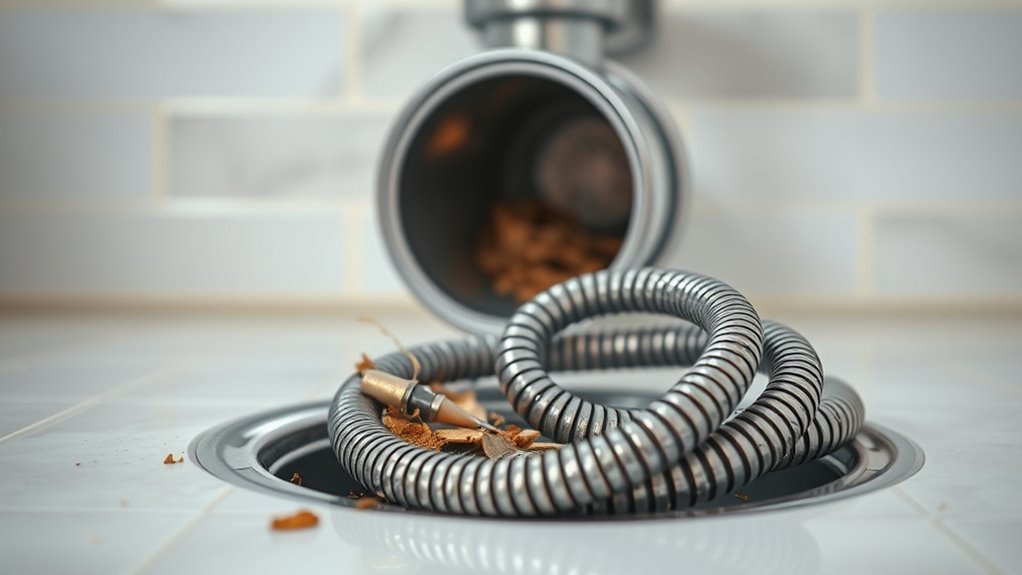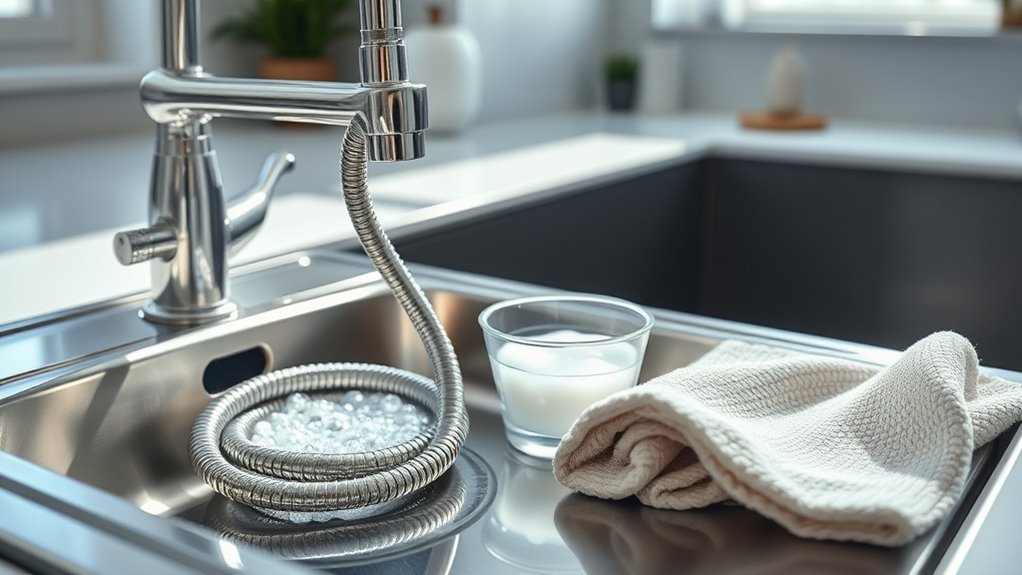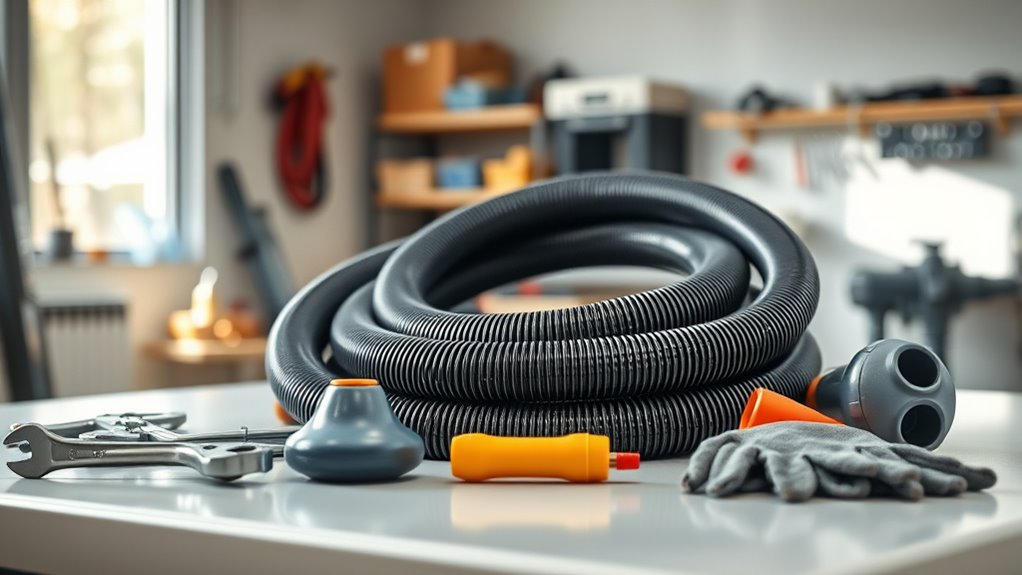How to Snake a Drain Pipe: Simple Steps to Clear Tough Clogs
To snake a drain pipe and clear tough clogs, first gather necessary tools like a plumbing snake and safety gear including gloves. Identify signs of a clog, such as slow draining water or gurgling sounds. Insert the snake into the drain with gentle pressure, maneuvering bends and dislodging the clog by twisting and pushing deeper. After clearing the blockage, test the drain for improved flow. Further insights can enhance the effectiveness of this process and guarantee proper maintenance.
Understanding Drain Clogs

Drain clogs can be a frustrating household issue that disrupts daily routines. They often occur due to the accumulation of debris, grease, hair, or foreign objects within pipes. When water cannot flow freely, it leads to slow drainage or complete blockages.
Understanding the causes of drain clogs is essential for effective prevention and resolution. Factors such as improper disposal of waste, aging plumbing systems, and tree root infiltration can exacerbate the problem.
Regular maintenance, including the use of strainers and periodic cleaning, can help reduce the likelihood of clogs. Awareness of warning signs, such as gurgling sounds or unpleasant odors, allows homeowners to address issues before they escalate, ensuring plumbing systems operate smoothly and efficiently.
Tools Needed for Snaking a Drain
When preparing to snake a drain, having the right tools is vital for effective results. A proper overview of essential tools will guarantee that the process runs smoothly, while a safety equipment checklist will help protect the user from potential hazards.
Understanding these components is key to successfully addressing drain clogs.
Essential Tools Overview
A successful drain snaking operation relies on having the right tools at hand. The selection of appropriate equipment can considerably enhance efficiency and effectiveness.
The essential tools for snaking a drain include:
- Plumbing Snake: A flexible metal cable designed to navigate through pipes and remove clogs.
- Auger: A more heavy-duty option, ideal for tougher clogs in larger pipes.
- Drain Cleaning Brush: Useful for loosening debris and preventing future clogs.
- Towels or Rags: Necessary for cleanup and to protect surrounding areas from spills.
Equipping oneself with these tools guarantees that the drain snaking process is manageable and successful, paving the way for a clearer plumbing system.
Safety Equipment Checklist
Proper safety equipment is essential for any drain snaking operation to guarantee the well-being of the individual performing the task. The right gear minimizes risks associated with clogs and debris. The following checklist outlines vital items needed for effective and safe snaking:
| Safety Equipment | Purpose |
|---|---|
| Gloves | Protects hands from sharp objects and chemicals |
| Safety Goggles | Shields eyes from debris and splashes |
| Face Mask | Prevents inhalation of dust and harmful particles |
| Knee Pads | Provides comfort and protection while working on floors |
Adhering to this safety checklist guarantees a safer environment, enabling a more efficient drain cleaning process. Prioritizing safety allows the individual to focus on the task at hand without unnecessary distractions or concerns.
Safety Precautions Before Starting
Before beginning the process of snaking a drain pipe, it is crucial to prioritize safety.
Wearing protective gear, such as gloves and goggles, can help prevent injuries and exposure to harmful substances.
Additionally, having all necessary tools gathered guarantees a smoother and safer operation.
Wear Protective Gear
Wearing protective gear is essential for anyone preparing to snake a drain pipe, as it minimizes the risk of injury and exposure to harmful substances. Proper precautions guarantee a safer experience during this often messy task.
Essential protective gear includes the following:
- Gloves: Durable, waterproof gloves protect hands from sharp objects and toxic materials.
- Safety goggles: Goggles shield the eyes from splashes and debris that may be released during the snaking process.
- Face mask: A mask can prevent inhalation of noxious fumes or dust that may arise from clogged materials.
- Knee pads: These provide comfort and protection for the knees when working in tight spaces or on hard surfaces.
Gather Necessary Tools
Gathering the necessary tools is an essential step in effectively snaking a drain pipe. A plumber’s snake, also known as a drain auger, is the primary tool required for this task; it comes in various lengths and thicknesses, suitable for different types of clogs.
Additionally, a pair of rubber gloves protects hands from debris and contaminants. A bucket will be useful to catch any water or waste that may overflow during the process. Having a flashlight can help illuminate dark spaces within the plumbing.
Finally, a plumbing wrench may be necessary to loosen any fittings or traps. Ensuring all tools are readily available before starting will streamline the snaking process and enhance safety.
Identifying the Clogged Pipe
Identifying the clogged pipe is an essential first step in resolving drainage issues.
Recognizing the location and nature of the blockage can greatly streamline the snaking process. Homeowners should consider the following indicators to pinpoint the clogged pipe:
- Slow Draining Water: Water pooling in sinks, tubs, or toilets often signifies a blockage.
- Unpleasant Odors: Foul smells emanating from drains can suggest trapped debris.
- Gurgling Sounds: Unusual noises during drainage may indicate air trapped behind a clog.
- Backflow Issues: Water backing up into fixtures points to a considerable blockage in the plumbing system.
Choosing the Right Snake Tool
Once the clogged pipe has been located, the next step involves selecting the appropriate snake tool for the job. Various types of drain snakes are available, each designed for specific applications.
For minor clogs in sinks or tubs, a hand-crank auger may suffice. For more severe blockages in larger pipes, a motorized drain snake is often necessary.
Moreover, selecting the correct diameter is essential; a 1/4-inch snake is typically suitable for smaller pipes, while larger pipes may require a 3/8-inch or 1/2-inch snake.
In addition, considering the snake’s length is important, as longer snakes can navigate deeper into plumbing systems.
Ultimately, choosing the right tool will greatly enhance the effectiveness of clearing the clog.
Preparing the Area for Snaking
Before beginning the snaking process, it is essential to gather all necessary tools, such as the snake itself, gloves, and a bucket.
Clearing the surrounding space guarantees a safe and efficient working environment. Proper preparation minimizes potential mess and allows for easier access to the drain pipe.
Gather Necessary Tools
To effectively snake a drain pipe, one must first gather the necessary tools, ensuring that the process runs smoothly and efficiently.
Having the right equipment minimizes frustration and enhances the likelihood of success.
Essential tools include:
- Plumber’s Snake: A flexible tool specifically designed to break up and remove clogs.
- Gloves: Protective wear to keep hands clean and safe from sharp objects or chemicals.
- Bucket: To catch any debris or excess water that may spill during the process.
- Flashlight: To illuminate dark areas, making it easier to see the clog and maneuver the snake.
With these tools at hand, one is well-prepared to tackle the task of snaking a drain pipe effectively.
Clear Surrounding Space
Having gathered the necessary tools, the next step involves preparing the area around the drain. It is crucial to create a clear workspace to facilitate effective snaking.
First, remove any items near the sink or toilet, such as cleaning supplies, towels, or decorative objects, to prevent damage and guarantee safety.
Next, lay down old towels or a waterproof mat to catch any spills or debris that may occur during the process. If applicable, turn off water supply valves to avoid accidental flooding.
Confirming adequate lighting will help illuminate the area for better visibility.
Finally, a bucket should be placed beneath the drain to collect any water or waste that may escape while snaking.
With a tidy and organized space, the snaking process can proceed smoothly.
Inserting the Snake Into the Drain
Once the drain snake is assembled and ready for use, it is essential to insert it carefully into the drain opening. Proper insertion is vital to avoid damaging the pipe or the snake itself.
The following steps should be considered during this process:
- Position the Snake: Align the snake with the drain opening, guaranteeing a straight entry.
- Apply Gentle Pressure: Slowly push the snake into the drain while maintaining a steady grip.
- Watch for Resistance: If resistance is felt, stop and assess the situation before proceeding further.
- Keep the Area Clear: Confirm that the surrounding area is free of obstructions to facilitate smooth handling.
Navigating the Snake Through the Pipe
With the snake securely inserted into the drain, the next task involves maneuvering it through the pipe to clear any blockages.
The user should begin by gently turning the handle of the snake, allowing the flexible coil to guide through bends and curves in the plumbing. It is vital to apply steady pressure while pushing the snake deeper into the pipe, as this aids in breaking up clogs.
If resistance is felt, the user should slightly pull back and rotate the snake again before continuing. This technique helps prevent damage to the pipe and guarantees that the snake can effectively reach the source of the blockage.
Patience is significant during this process, as maneuvering complex plumbing systems may require time and finesse.
Removing the Clog
As the snake reaches the clog, the user should begin to twist and push it deeper into the blockage. This action helps the snake to break apart the clog and create a clear passage.
Users must be patient, as it may take several attempts to completely remove the obstruction. Effective techniques include:
- Twisting the snake: Helps to dislodge stubborn materials.
- Pulling back slightly: Allows the user to assess the clog’s response.
- Reinserting the snake: Sometimes necessary for larger clogs.
- Listening for changes: Sounds can indicate whether the blockage is loosening.
Once the clog begins to break apart, the water flow should gradually improve. Continued effort may be needed until the drain is fully clear.
Cleaning the Snake After Use

After successfully clearing the clog, attention must turn to cleaning the snake to guarantee it remains in good condition for future use. Proper maintenance extends the snake’s lifespan and guarantees effective performance during subsequent tasks.
Here are key cleaning steps to follow:
| Step | Description |
|---|---|
| Rinse the Snake | Use water to wash off debris. |
| Inspect for Damage | Check for kinks or rust. |
| Dry Thoroughly | Ascertain it is completely dry. |
| Store Properly | Keep it in a dry, safe place. |
Following these steps will help maintain the snake’s functionality and prevent corrosion, making it ready for the next unclogging job. Regular cleaning is essential for peak performance and longevity.
Testing the Drain After Snaking
Testing the drain after snaking is an essential step to verify that the clog has been completely removed and that the plumbing system is functioning properly. This process guarantees that water flows freely, preventing future issues.
To effectively test the drain, consider the following actions:
- Run Water: Turn on the faucet to allow water to flow through the drain for several minutes.
- Check for Backups: Observe if any water backs up, indicating a remaining obstruction.
- Listen for Sounds: Pay attention for gurgling noises, which may suggest that air is trapped in the pipes.
- Inspect Drainage Speed: Note how quickly the water drains; slow drainage may signify lingering issues.
These steps verify the effectiveness of the snaking process and the overall health of the plumbing system.
Preventative Measures for Future Clogs
To prevent future clogs, regular drain cleaning is essential for maintaining ideal flow.
Additionally, using drain screens can effectively catch debris before it enters the pipes.
Implementing these measures can greatly reduce the risk of blockages over time.
Regular Drain Cleaning
Regular drain cleaning is crucial for maintaining a healthy plumbing system and preventing future clogs. By routinely addressing debris buildup and organic material, homeowners can greatly reduce the likelihood of serious blockages.
This proactive approach not only saves time and money but also enhances the efficiency of the plumbing system.
Here are some effective regular drain cleaning practices:
- Hot Water Flush: Pouring boiling water down drains helps dissolve grease and soap buildup.
- Baking Soda and Vinegar: This natural combination can break down minor clogs and neutralize odors.
- Regular Inspections: Periodically checking pipes for leaks or signs of wear can prevent bigger issues.
- Professional Cleaning: Scheduling annual cleanings with a plumber guarantees thorough maintenance and peace of mind.
Use Drain Screens
Utilizing drain screens can considerably reduce the risk of clogs in household plumbing systems. By catching debris such as hair, food particles, and soap scum, these simple devices help maintain clear drains and minimize the need for frequent snaking. Installing drain screens is an effective preventative measure that can save homeowners time and money in the long run.
| Type of Drain Screen | Benefits | Maintenance Required |
|---|---|---|
| Mesh Screens | Catches small debris | Clean weekly |
| Solid Screens | Blocks larger particles | Clean monthly |
| Pop-Up Strainers | Easy to remove and clean | Clean bi-weekly |
| Magnetic Screens | Easy installation | Clean as needed |
Incorporating these screens into plumbing systems guarantees better flow and reduces the likelihood of future clogs.
When to Call a Professional

While many minor clogs can be addressed with DIY methods, there are specific situations when calling a professional is the best course of action.
Homeowners should consider enlisting expert help if they encounter any of the following scenarios:
- Persistent clogs that return after multiple attempts to clear them
- Multiple drains in the home are experiencing issues simultaneously
- There is a noticeable foul odor, indicating a possible sewage problem
- The homeowner is unsure about the proper use of a drain snake or other tools
In these cases, a professional plumber can provide the expertise needed to diagnose the issue accurately and implement effective solutions, ensuring the plumbing system functions smoothly once again.
Common Misconceptions About Snaking Drains
Many homeowners hold misconceptions about the process of snaking drains, often leading to ineffective methods or unnecessary frustration.
One common belief is that snaking can clear all types of clogs, when in reality, certain blockages may require different approaches. Additionally, some individuals think that a single pass with the snake is sufficient, overlooking the need for multiple attempts in tougher situations.
Another misconception is that snaking can damage pipes, yet when done correctly, it is a safe method for maintenance.
Finally, many assume that snaking is a quick fix, not recognizing that the process can take time and requires patience.
Understanding these misconceptions can help homeowners approach drain issues more effectively and with realistic expectations.
Alternative Methods for Clearing Clogs
When traditional snaking methods fall short, homeowners can explore several alternative techniques for clearing clogs.
These methods offer effective solutions that may suit different situations or preferences.
- Baking Soda and Vinegar: This natural combination can help dissolve minor clogs and deodorize pipes.
- Boiling Water: Pouring boiling water down the drain can help break up grease or soap buildup.
- Wet/Dry Vacuum: This tool can suck out clogs from sinks or tubs, provided there is a proper seal.
- Enzymatic Cleaners: These biological cleaners use enzymes to break down organic material in pipes, offering a more environmentally friendly option.
Conclusion
To summarize, snaking a drain pipe can be likened to untangling a stubborn knot in a necklace; patience and the right tools are essential for success. Just as one carefully works through each twist and turn to restore the beauty of the jewelry, so too can a homeowner tackle tough clogs with methodical precision. By following the outlined steps and understanding the process, individuals can regain the flow of their plumbing and prevent future blockages.


